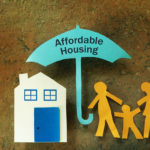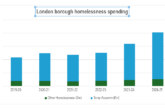Approximately one in 50 Londoners are now homeless and living in temporary accommodation, according to new research from London Councils [1].
Based on its latest survey of boroughs’ homelessness data, the cross-party group estimates the number of homeless residents in temporary accommodation has risen to almost 170,000 [2]. This figure includes 83,500 children — meaning on average at least one child in every London classroom is homeless [3].
Amid a worsening shortage of affordable housing, there has also been a dramatic 781% increase in homeless families placed in bed and breakfast accommodation beyond the legal six-week limit [4]. This equates to an additional 1,141 London families stuck in unsuitable B&B accommodation in April 2023 compared to the same month last year.
London Councils warns that the crisis is increasingly unmanageable. Boroughs are calling for emergency action from the government to help low-income households meet their housing costs and to address the enormous financial pressures facing local homelessness services.
London Councils’ survey of the boroughs provides a more up-to-date overview of the situation across the capital than the government’s homelessness data, for which there is a six-month lag in publication timeframes. Key findings from the latest survey include:
- London Councils estimates there are now 169,393 homeless Londoners living in temporary accommodation, including 83,473 children.
- The number of households entitled to homelessness support from a London borough (i.e. owed a homelessness prevention or relief duty) increased 15.2% between April 2022 and April 2023.
- Due to the lack of alternative housing, boroughs are becoming more reliant on the last resort option of placing homeless families in B&B accommodation. The number of families placed in B&Bs doubled between April 2022 and April 2023 (up from 1,543 to 3,242) – an increase of 110%.
- The number of families living in B&Bs beyond the six-week limit increased by 781% – from 146 in April 2022 to 1,287 in April 2023.
- Rising homelessness numbers are putting immense strain on boroughs’ finances. London Councils estimate that boroughs are collectively spending £60m each month on temporary accommodation costs. In addition, it is estimated that the net deficit across London boroughs’ homelessness services is on course to reach £244m in 2023-24, an increase of 37% on the estimated deficit in 2022-23 [5].
Recent research commissioned by London Councils and partners shows a 41% reduction in the number of London properties available for private rent since the Covid-19 pandemic. The study, undertaken by Savills and the LSE, also found that only 2.3% of London listings on Rightmove in 2022-23 were affordable to low-income households using Local Housing Allowance to pay their rent.
London Councils points to the reduction in the supply of private rental housing as a major factor behind the capital’s fast-rising homelessness pressures — including boroughs’ difficulty in securing temporary accommodation for homeless families. Combined with the cost-of-living crisis and longstanding shortage of affordable homes, boroughs describe the housing situation as disastrous.
London has the highest homelessness figures in the country, accounting for more than half the overall number of households in England living in temporary accommodation.
Cllr Darren Rodwell, London Councils’ Executive Member for Regeneration, Housing & Planning, said: “This is the latest evidence of the homelessness disaster unfolding in the capital. One in 50 Londoners homeless and living in temporary accommodation is an appalling statistic.
“We are especially concerned by the skyrocketing numbers of families stuck in B&Bs. Nobody wants this happening and boroughs do everything we can to support homeless families into suitable accommodation. However, more and more often boroughs face a total lack of other options for keeping a roof over these families’ heads.
“Homelessness pressures across the capital are fast becoming unmanageable. Ministers need to treat this as the emergency it clearly is. Much more action is needed to help low-income households avoid homelessness and to reverse the rising numbers relying on temporary accommodation.”
London Councils is urging the Government to:
Raise Local Housing Allowance (LHA). LHA, which eligible households receive as part of their housing benefit or Universal Credit if they have a private landlord, has been frozen since 2020 despite private rents increasing since then. Boroughs believe LHA should be increased to cover at least 30% of local market rents — a policy the government adopted successfully at the height of the Covid-19 pandemic.
Support councils to buy accommodation sold by private landlords. The government should build on initiatives such as the Local Authority Housing Fund by providing increased capital investment for housing acquisitions, particularly to acquire homes being sold by private landlords as they exit the market.
Boost Homelessness Prevention Grant funding. Local authorities play a vital role in supporting struggling households to avoid homelessness. Councils require an emergency funding increase to ensure local services have the resources needed in the face of rising levels of demand for support.
Increase Discretionary Housing Payments. These payments are used by councils to help residents in financial crisis meet their housing costs. They are an essential homelessness prevention tool, but government funding for Discretionary Housing Payments in 2023-24 has been frozen at 2022-23 levels, despite significantly increasing homelessness pressures.
Bring forward a cross-departmental strategy to reduce homelessness. Tackling homelessness must become a major priority at a national level with government departments working together — in addition to key partners such as local authorities — as effectively as possible.
[1] Calculated by dividing London’s population (8,796,628 at the 2021 census) by London Councils’ latest estimate of the number of homeless individuals in temporary accommodation (169,393).
[2] London Councils surveyed all London local authorities for their latest homelessness data, which covered March and April 2023. London Councils received survey responses from 28 boroughs. To ensure a pan-London assessment of the capital’s homelessness pressures, London Councils supplemented the 28 responses with estimated figures for the remaining boroughs by applying the average year-on-year increase from the responses received to the official homelessness statistics for March 2022. The official homelessness statistics for March 2023 are missing data from nine boroughs so London Councils considers this estimate a more accurate representation of the capital’s homelessness population.
[3] Census 2021 found 1,898,062 residents in London aged 0-17. Government statistics suggest average class sizes in London range between 22 and 26.
[4] The Government’s Homelessness Code of Guidance states that “if no alternative accommodation is available for the applicant the housing authority may accommodate the family in B&B for a period, or periods, not exceeding 6 weeks in result of a single homelessness application.” Boroughs recognise it is highly detrimental to break this 6-week rule. Families will only be accommodated in B&Bs for longer periods when no other options are available for the borough to fulfil its housing duty, and boroughs will still work to find more suitable accommodation as quickly as possible.
[5] These estimates are produced using London Councils’ survey data to calculate an average borough figure and then extrapolating from this to an all-London total.
Header image:©zimmytws/AdobeStock










